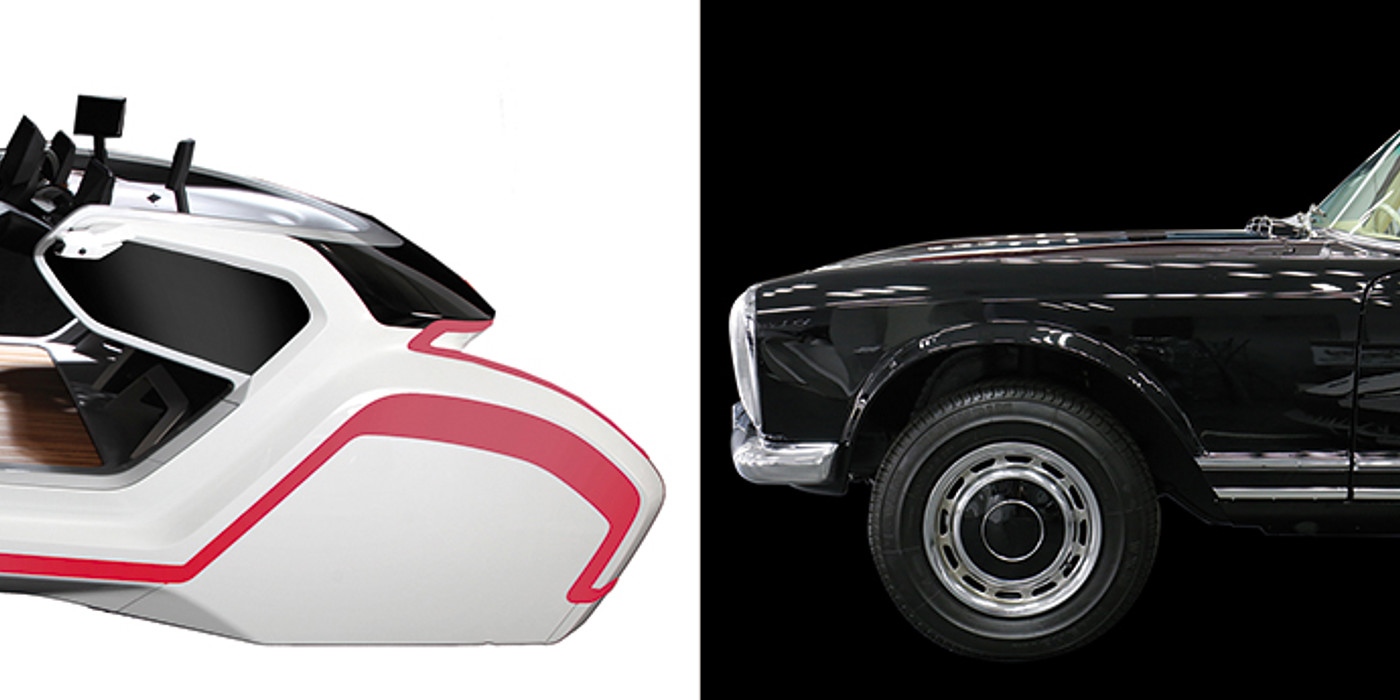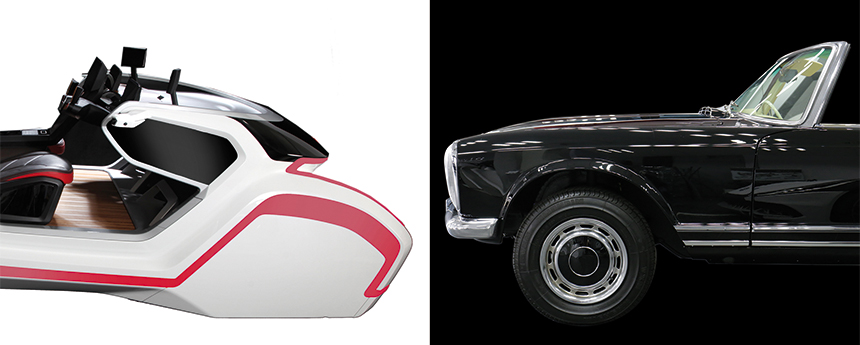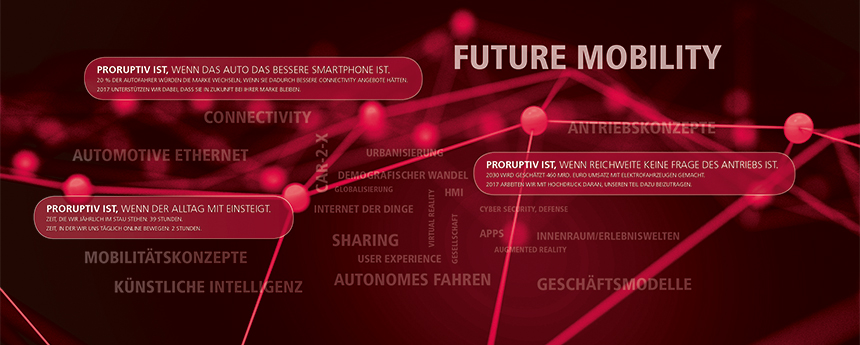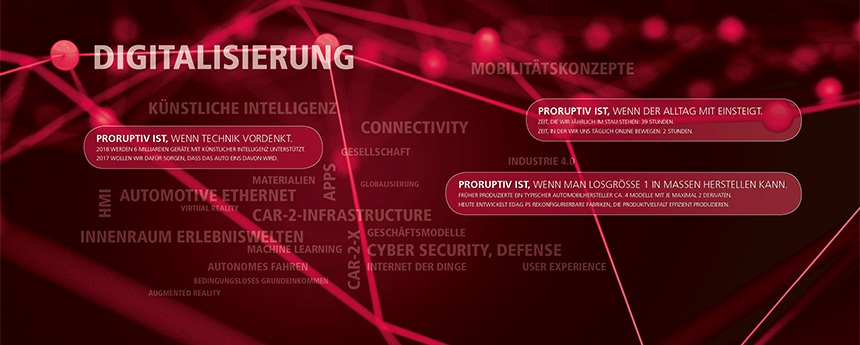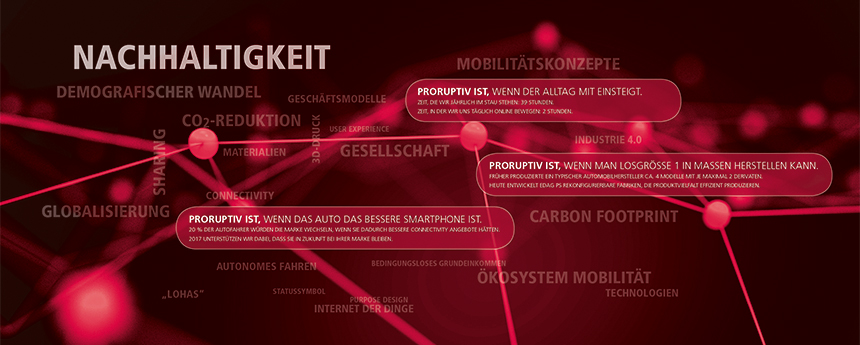From electric vehicles, autonomous driving, connectivity, 3D printing and new mobility concepts to the fully networked manufacturing of Industry 4.0: are we on the threshold of the complete reinvention of the product "automobile"? Never before in the history of the automotive industry has the question "quo vadis" been as pertinent as it is today. Aside from the discussion regarding alternative powertrains, the digitisation of the auto industry is a further dominant theme at this year's Geneva Motor Show. "Disruption" is, however, a frequently anticipated by-effect of the digital transition. The engineering specialists EDAG are presenting their engineering concept for greater sustainability and profitability in Geneva: "Create for the best. Be proruptive". This concept is proof that improving established solutions without avoiding state-of-the-art technologies and methods can be very worthwhile.
A supposed contradiction can be seen at the EDAG Group's stand: a Bosch show car and a restored 1968 Mercedes Pagode model.
Designed and realised for Bosch by EDAG, the futuristic show car represents a far-reaching interconnectivity of the vehicle with the digital world. Bosch presents the way in which the highly automated vehicle of the future will develop into a third sphere of life, in addition to the home and the workplace. In this way, the personalised communication between the car and driver has been expanded: new functions connect the vehicle with the environment, the smart home, smart city, or car repair shop. And open the way to highly automated driving. Connectivity turns the car into an assistant on four wheels.
"We are also working intensively on forward-looking subjects such as connectivity, HMI, e-mobility and the Ethernet in the vehicle," said Jörg Ohlsen, CEO of the EDAG Group. "These features will help to successively increase the comfort and safety of driving. We do not, however expect an abrupt change - particularly when it comes to alternative drive concepts - but rather a transition phase during which conventional and the latest technology will exist parallel to each other. This implies greater market opportunities and volumes for us as engineering specialists. But also expectations that we will continually expand our skills and develop new business fields."
With the 1968 Mercedes 280 SL, EDAG demonstrates the fact that new technologies also enable the processes for restoring automobile classics to be much improved. Not only did the EDAG specialists return the legendary Pagode to top condition, in fact they improved on its original delivery condition.
They did this by fitting modern features, to ensure that the car meets today's safety requirements.
Proruptive is when old documents become digital
When restoring vintage cars, the procurement of spare parts is often an enormous challenge, and sometimes simply no longer possible. "If components are no longer available, then we use digital tools to create new ones that are true to size," explained Jörg Ohlsen. One example is the existing boot lid, which was not in very good condition; this was digitised and then compared with the original drawings. On this basis, a digital data record of the component was created 49 years later, which was then used to design and produce the corresponding tools. The result was that ideal conditions were created for the modern, rapid production of components for the future restoration of further models from this series.
For smaller exterior and interior components, the use of additive manufacturing (3D printing) can offer significant advantages. Particularly with restoration projects where only one single part is needed, the tool-less production or printing of parts is an interesting, fast, and above all low-cost solution. These examples show how, with modern technology, it is possible not only for automobile treasures to be restored and preserved for the future, but also for new business models to be generated.
For us, this is proruptive thinking.
Proruptive is when additive manufacturing helps to make vehicle bodies lighter and more flexible
The increasing number of drive concepts and the high degree of model variety call for maximum flexibility in the vehicle bodies of tomorrow. This is difficult and, more importantly, not economically feasible with conventional body concepts. With a bionically optimised, hybrid spaceframe, EDAG demonstrates a new angle on how to bring about a changeable, flexibly manufactured body concept. Its success lies in the combination of printed body nodes and intelligently finished, conventionally manufactured sections. The advantages of 3D printing can be put to optimum use here.
The many different nodes required for the different vehicle variants can be produced without tools and at low cost, even where small quantities are concerned. Steel or aluminium sections serve as connecting elements between the printed nodes. The result is a bionically designed, load path-optimised spaceframe structure. As the process uses very little in the way of equipment and tools, it will be possible for all body variants to be produced economically and with the maximum possible flexibility in the future. The project was carried out in cooperation with Laser Zentrum Nord (Hamburg), Concept Laser (Lichtenfels) and the BLM Group (Levico, Italy).
This example, too, shows that it is worthwhile to employ new technologies such as 3D printing to improve tried and tested vehicle architectures and production processes.
Proruptive is when development immediately proves useful
The proruptive attitude is not restricted to new technologies for the vehicle itself, but is also applicable for its development process. If, to keep up with the speed of digitisation, requirements and customer preferences need to be incorporated into development more and more quickly and at ever-shorter notice, then automobile developers will have to react more swiftly in the future. The IT industry has shown the way forward with its SCRUM concept, which might it be possible to adapt to serve as a blueprint for automotive engineering. SCRUM is an agile process in which the team frequently gets together at short intervals (generally every day), to discuss how work is progressing and exchange ideas. Communication with the customer is also in short bursts; new requirements and customer preferences are accepted at shorter intervals, packed into small work packages - known as sprints - and prioritised. These "sprints" are the subject of daily scrum meetings attended by everyone involved in the project, and a key element of an agile development process. The scrum process makes it possible to be in very close contact with the customer, as the sprint planning means that changes to customer requirements can be dealt with quickly. The EDAG Group is currently implementing this technique in the app development of the brand trive.me. Even for the development of new, revolutionary operating and screen concepts (HMI), SCRUM is a profitable concept.
With its examples of proruptive engineering, the EDAG Group demonstrates a means of bringing about the sustained improvement of existing technologies in Geneva. We are therefore concentrating on developing new trends, bearing in mind what already worked well in the past - not just in the automotive sector. Because where we come from, we know that we are paving the way for progress. And because we have the quest for excellence at our core, we we also want to improve on disruption in the future.
With "proruptive innovation" - the sustainable engineering concept that, far from unsettling people and markets with uncertainties, employs knowledge to move them on to the technologically best stage.
